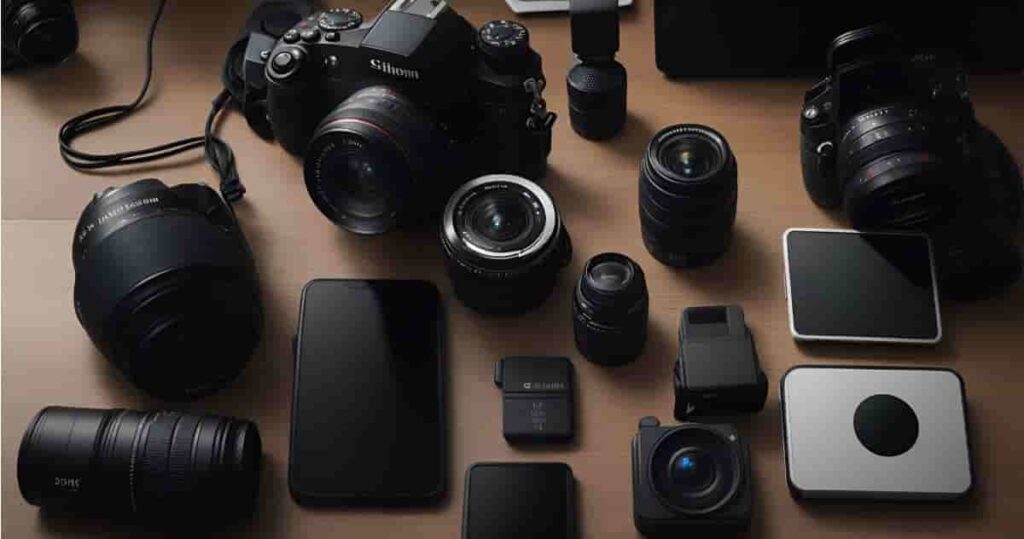Welcome to our blog, where we venture into the captivating universe of cameras to help you uncover the one that perfectly complements your photographic aspirations. If you have dreams of becoming an artist or if you have been working in the industry for a long time, recognizing the importance of “the best Camera” is the initial milestone in turning your ideas into captivating visual narratives. In a society where every single moment possesses the potential of being a masterpiece, the pursuit of finding “the best Camera” becomes an exciting journey filled with enthusiasm and limitless opportunities. It goes beyond simply acquiring a piece of advanced device; it is an expedition to unleash the human imagination through the medium of photography.
The Best Camera is more than a tool; it’s a trusted companion on your journey to capture life’s breathtaking moments. It’s the bridge between your imagination and the canvas of reality, enabling you to weave intricate tales of landscapes, portraits, and everything in between. This exceptional device allows you to dance with light and shadow, mastering the art of exposure, focus, and composition, no matter the setting. It empowers you to embrace the magic of golden hours, starry nights, and bustling streets, ensuring that each photograph encapsulates the essence of the moment. So, join us as we embark on this exploration to discover “the Best Camera” that will become an extension of your creative soul, a faithful ally in your pursuit of visual excellence.
Top 12 Best Cameras In 2024
| 1 | Sony Alpha 7 IV: Best Overall |
| 2 | Nikon Z9: Best Camera for Professionals |
| 3 | Canon EOS R50: Best Budget Camera |
| 4 | Nikon D850: Best Camera for Stills |
| 5 | Panasonic Lumix S5 II: Best Camera for Videography |
| 6 | Canon EOS Ra: Best Camera for Astrophotography |
| 7 | Sony Alpha 1: Best Camera for Wildlife Photography |
| 8 | GoPro Hero12 Black: Best Camera for Sports Action |
| 9 | Olympus OM-D E-M1 Mark III: Best Camera for Wedding Photography |
| 10 | Fujifilm Instax Mini 12: Best Instant Camera |
| 11 | Sony RX100 VII: Best Camera for Travel |
| 12 | Samsung Galaxy S23 Ultra: Best Camera Phone |
The Best Camera – Reviews
1. Sony Alpha 7 IV: Best Overall
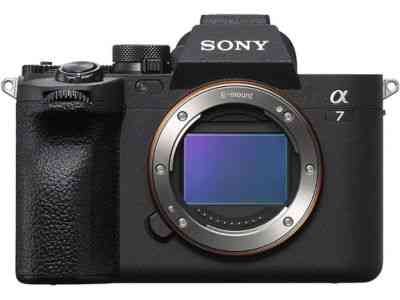
Specifications
- Type: Mirrorless
- Sensor: Full Frame (35mm)
- Megapixels: 33 MP
- Lens Mount: Sony E
- Monitor: 3.0″ Free-Angle Tilting Touchscreen LCD, 1036k Dots
- Viewfinder: OLED EVF, 3680k dots, 100% coverage, 0.78x magnification
- Max continuous shooting speed: 10fps
- Max video resolution: 4K
Pros
- Higher Resolution
- Bird eye autofocus
- Great stabilization
Cons
- Overheating Issue
The Sony α7 IV stands as an exceptional camera for photography. Positioned as a versatile hybrid model, it falls just short of the professional tier. Distinguishing itself from its well-received predecessor, the Sony A7 III, the α7 IV boasts a higher-resolution 33-megapixel sensor. This sensor upgrade results in capturing highly detailed images with ample flexibility for cropping and post-processing. The camera demonstrates an impressive dynamic range, and Sony’s real-time autofocus system continues to set the industry standard.
Nonetheless, it’s important to acknowledge that perfection eludes this camera. While it does feature in-body image stabilization (IBIS), we have encountered more impressive implementations of stabilization in other models. Notably, if you require the capability to shoot uncompressed RAW files, the α7 IV’s maximum burst rate drops to a somewhat disappointing 6 frames per second. This limitation may prove suboptimal for those engaged in high-level sports or wildlife photography. In contrast, the Canon EOS R6 Mark II surpasses the α7 IV in this regard, boasting a 12 fps burst shooting rate (or up to 40 fps in electronic shutter mode).
However, the α7 IV enjoys a compelling advantage thanks to the extensive array of lenses available for Sony’s E-mount, including numerous third-party options spanning various price ranges. This edge becomes particularly significant as Canon maintains its RF mount as a proprietary domain, excluding third-party offerings.
It’s important to note that the α7 IV has shifted from its predecessor’s position as an entry-level full-frame camera, as it now commands a higher price point. This transition is substantiated by the inclusion of the Bionz XR processor, which delivers commendable performance and largely justifies the additional investment.
As with any hybrid camera, certain trade-offs exist. Notably, there is a significant crop factor in 4K video recording, and the camera may not be the most user-friendly option for beginners.
Also Check: Best Mirrorless Camera
2. Nikon Z9: Best Camera for Professionals
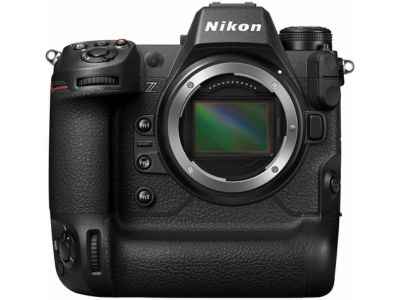
Specifications
- Type: Mirrorless
- Sensor: Full Frame
- Megapixels: 45.7 MP
- Lens Mount: Nikon Z
- Monitor: 3.2″ Tilting Touchscreen LCD, 2100k Dots
- Viewfinder: OLED EVF, 3,690k dots, 100% coverage, 0.8x magnification
- Max continuous shooting speed: 20fps
- Max video resolution: 4K
Pros
- Amazing Autofocus in Low lights
- Great Subject Detection
- High Resolution
- Excellent Video shoots
Cons
- No Flip-out Display
- Bulky
Undoubtedly, the Nikon Z9 has surfaced as an exceptionally impressive camera that stands out among the rest. It undoubtedly carries a price tag that firmly places it in the domain of professional photographers and videographers who depend on their craft for their livelihood. This camera excels in both aspects, demonstrating itself to be an extraordinary instrument for individuals who strive for perfection in the fields of photography and videography.
In the realm of capturing swift and dynamic moments, such as those found in sports, wildlife, weddings, and events, the Nikon Z9 truly shines. Its burst shooting capabilities are nothing short of remarkable, delivering a stunning 20 frames per second in RAW format and an astonishing 120 frames per second when opting for lower-quality JPEG. This means that crucial moments will not escape your lens when you have the Z9 in hand. Moreover, its prowess in face and eye detection and tracking is second to none.
While the Nikon Z9 undoubtedly stands out as an incredible camera, it may not be the first choice for dedicated astrophotographers, especially those exclusively focused on capturing celestial phenomena. However, it does find its niche in occasional astrophotography endeavors combined with the diverse photography styles mentioned earlier.
Notably, the camera’s substantial battery life is a significant advantage. During our tests, it displayed remarkable endurance, losing less than 20 percent of its charge after a continuous three-hour session of astrophotography.
Additionally, the Nikon Z9 impresses with its range of connectivity options. It offers versatile features such as Snapbridge for convenient file transfers, Wi-Fi, Bluetooth, ethernet connectivity, and USB-C support, ensuring photographers can seamlessly integrate it into their workflow.
3. Canon EOS R50: Best Budget Camera
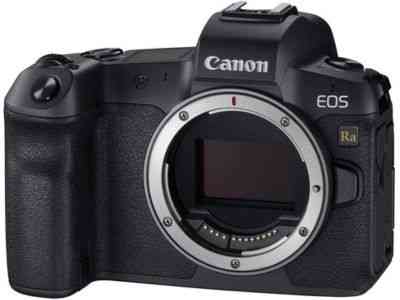
Specifications
- Type: Mirrorless
- Sensor: APS-C Sensor
- Megapixels: 24.2 MP
- Lens Mount: Canon RF
- Monitor: 3″ Tilting Touchscreen LCD, 1620k Dots
- Viewfinder: OLED EVF, 2360k dots, 100% coverage, 0.96x magnification
- Max continuous shooting speed: 15fps
- Max video resolution: 4K
Pros
- Lightweight
- Great Image Quality
- Affordable Price
- Easy to Use
Cons
Battery life could be improved
The remarkable Canon EOS R50 undeniably stands out as one of the most budget-friendly cameras currently available in the market. It proves to be an excellent choice for amateur photographers, primarily due to its straightforward and intuitive controls, combined with a wide variety of automated shooting modes that empower newcomers to explore diverse photography techniques. Furthermore, its autofocus system, renowned for its accuracy and user-friendliness, enhances its appeal. The camera’s portability, suitable for both travel and street photography, is worth emphasizing, given its compact and lightweight structure. The highly versatile Canon EOS R50, a mirrorless camera of distinction, showcases an advanced range of features tailored to meet the demands of both photography and videography. It targets content creators and vloggers and distinguishes itself by being more compact and lighter than the EOS M50 Mark II. Furthermore, it showcases an enhanced 24.2MP APS-C CMOS sensor and DIGIC X image processor, delivering impressive high-resolution stills and UHD 4K videos.
In contrast to the Canon EOS M50 Mark II, which it effectively replaces, the EOS R50 exhibits an enticing advantage: it shares the same lens mount as full-frame Canon counterparts like the Canon EOS R6 Mark II. This unique characteristic permits users to utilize both APS-C and full-frame lenses with the R50, facilitating a smoother transition to a full-frame camera in the future.
4. Nikon D850: Best Camera for Stills
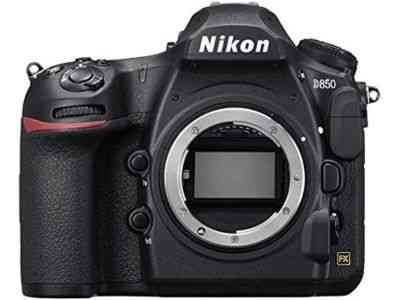
Specifications
- Type: DSLR
- Sensor: Full-Frame CMOS
- Megapixels: 45.7 MP
- Lens Mount: Nikon F
- Monitor: 3.2″ Tilting Touchscreen LCD, 2359k Dots
- Viewfinder: Optical (Pentaprism), 100% coverage, 0.75x magnification
- Max continuous shooting speed: 7fps
- Max video resolution: 4K
Pros
- Versatility
- Amazing Image Quality
- Fast Autofocus
- Responsive screen
Cons
- Lacks Built-in Flash
The Nikon D850 stands as one of the best DSLR cameras designed for multimedia purposes, seamlessly combining robust still photography capabilities with adept movie and time-lapse recording functions. At its core lies a freshly engineered 45.7MP BSI CMOS sensor and the trusted EXPEED 5 image processor, setting the D850 apart with its remarkable high-resolution performance for capturing intricate details.
The image sensor’s innovative back-illuminated design excels in low-light scenarios, rendering greater detail and clarity, all while forgoing the inclusion of an optical low-pass filter to enhance sharpness. Teaming up with this sensor is the EXPEED 5 image processor, jointly delivering a continuous shooting speed of 7 frames per second for capturing up to 51 consecutive frames. The camera boasts an expandable sensitivity range spanning from ISO 32 to 102400, ensuring exceptional flexibility. Furthermore, it offers 4K UHD video recording options, with the choice of either a DX crop or utilizing the full-frame sensor. For the creative, there’s an 8K time-lapse recording mode, along with specialized recording modes tailored for digitizing film negatives and focus stacking applications.
In terms of its physical design, the D850 strikes a delicate balance between functionality and elegance. A substantial optical pentaprism, boasting a wide field of view and 0.75x magnification, delivers a clear and realistic view that’s indispensable for precise photography. The camera’s weather-sealed construction makes it suitable for operation in various environmental conditions. Additionally, photographers have the good option to enhance shooting endurance and continuous shooting rates by adding the optional MB-D18 grip.
Also Check: Best DSLR Camera
5. Panasonic Lumix S5 II: Best Camera for Videography
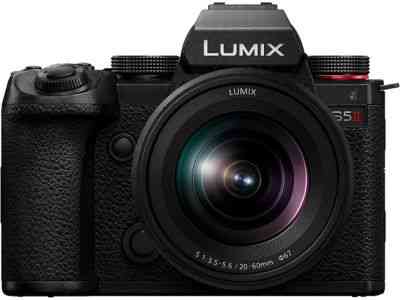
Specifications
- Type: Mirrorless
- Sensor: Full-Frame CMOS
- Megapixels: 24.2 MP
- Lens Mount: Leica L
- Monitor: 3″ Free-Angle Tilting Touchscreen LCD, 1840k Dots
- Viewfinder: OLED EVF, 3680k dots,, 100% coverage, 0.78x magnification
- Max continuous shooting speed: 9fps
- Max video resolution: 6K
Pros
- Excellent Image Quality
- Improved Autofocus
- Amazing Video Functionalities
Cons
- Battery Life could be improved
The Lumix S5 II has a newly crafted 24.2-megapixel full-frame CMOS sensor, mirroring the resolution of the original S5. However, a significant upgrade lies in the improved autofocusing system. For videographers seeking high-resolution slow-motion video, the camera supports 120p video capture, and there’s the option for RAW HDMI output through an additional license upgrade.
The Lumix S5 II excels in the realm of video recording, offering unlimited 4K/60p recording internally, as well as high-speed 60fps recording in 4K/60p and FHD/180p. Furthermore, it provides the versatility of up to 6K video recording with a full sensor readout, establishing itself as a top choice for content production. The camera continues to feature a subject detection system capable of recognizing and tracking both humans and animals. However, it lacks a vehicle recognition mode, setting it apart from some recent camera models.
When it comes to connectivity, the Lumix S5 II offers built-in Bluetooth and Wi-Fi, providing a range of practical features. You can use your smartphone as a straightforward Bluetooth shutter release or take full control of the camera remotely, complete with a live view feed. After your shooting session, you can effortlessly transfer images from the camera to your phone. In terms of performance, the S5 II proves to be a dependable companion. It typically powers up almost instantly upon activation, although there are instances where it may take a couple of seconds for the live view display to appear, likely related to the camera establishing a Bluetooth connection with your phone. Once operational, it exhibits responsiveness and speed, whether you’re interacting with physical controls or utilizing the touchscreen interface.
6. Canon EOS Ra: Best Camera for Astrophotography
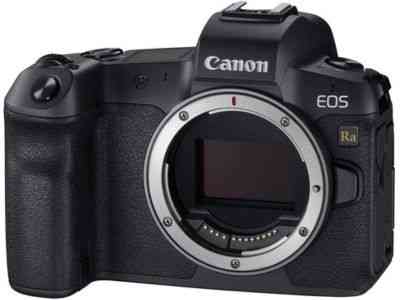
Specifications
- Type: Mirrorless
- Sensor: Full-Frame CMOS
- Megapixels: 30.3 MP
- Lens Mount: Canon RF
- Monitor: 3.15″ Free-Angle Tilting Touchscreen LCD, 2100k Dots
- Viewfinder: OLED EVF, 3690k dots,, 100% coverage, 0.71x magnification
- Max continuous shooting speed: 8fps
- Max video resolution: 4K
Pros
- Good Battery Life
- Great High ISO Performance
- Amazing Ergonomics
- User-Friendly Touch Screen
Cons
- Pricey
Crafted with a specific focus on astrophotography enthusiasts, the Canon EOS Ra represents a tailored iteration of the original EOS R camera. It introduces a noteworthy addition in the form of an optical IR cut filter placed in front of the sensor. This modification significantly enhances the camera’s ability to capture distant nebulae and other celestial phenomena with exceptional clarity. By incorporating this dedicated filter, the EOS Ra achieves a remarkable fourfold improvement in the transmission and sensitivity to H-alpha (656.28nm) wavelengths. This enhancement ensures that nebulae and other astronomical subjects can be depicted with a heightened level of color accuracy, free from unwanted infrared contamination.
Furthermore, the EOS Ra introduces a valuable feature in the form of a 30x live view magnification setting. This innovation improves the precision of focusing when working with distant subjects, whether through the electronic viewfinder (EVF) or the rear LCD screen. It’s important to note that, beyond these specific adjustments, the EOS Ra and EOS R share the same core features, facilitating the creation of high-resolution, finely detailed images. The autofocus system aligns seamlessly with the camera’s UHD 4K video recording capabilities, further complemented by Movie Digital IS, which effectively reduces the impact of camera shake on video recordings.
7. Sony Alpha 1: Best Camera for Wildlife Photography

Specifications
- Type: Mirrorless
- Sensor: Full-Frame CMOS
- Megapixels: 50.1 MP
- Lens Mount: Sony E
- Monitor: 3.0″ Free-Angle Tilting Touchscreen LCD, 1440k Dots
- Viewfinder: OLED EVF, 9437k dots, 100% coverage, 0.9x magnification
- Max continuous shooting speed: 30fps
- Max video resolution: 8K
Pros
- Great Low-light Performance
- High Dynamic Range Sensor
- Superfast Autofocus
Cons
- Pricey
The Sony A1 immediately felt familiar, as its design closely resembles that of the A7R Mark IV, marking the fourth generation of Sony’s full-frame mirrorless cameras. This design continuity is reassuring. The camera’s size remains similar to its predecessors, but the grip has been improved for greater comfort, and the buttons provide more satisfying tactile feedback. Despite its capabilities, it maintains a manageable weight and feels ergonomic when held.
One of the standout features of mirrorless cameras is Eye AF, and it’s become a personal favorite. In the past, it wasn’t always the most reliable, but over time, it has greatly improved, simplifying portrait photography. For wildlife and nature photographers, the Sony Alpha 1 has proven to be an exceptional tool to achieve their photographic aspirations. It can shoot at a remarkable 30 frames per second, capturing 155 shots before the buffer fills up. Notably, these are full-resolution, uncompressed raw images with a remarkable 50.1 million pixels. When coupled with its outstanding autofocus system, this makes it one of the finest choices for sports and wildlife photography. The practical outcome is that the camera excels in subject recognition and tracking. When capturing images of people, animals, and birds, the camera’s eye-detection autofocus ensures impressive results even in challenging scenarios, where other elements vie for attention in the frame, demonstrating the camera’s ability to discern the primary subject.
8. GoPro Hero12 Black: Best Camera for Sports Action
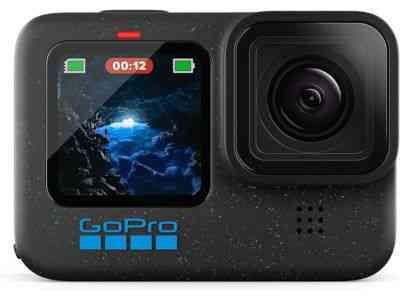
Specifications
- Type: Action Camera
- Sensor: CMOS Sensor
- Megapixels: 24.7 MP
- Max continuous shooting speed: 60fps
- Max video resolution: 5.3K
Pros
- Great Stabilization
- Improved Battery life
- Easy-to-use Menu System
Cons
- Overheating Issue
- No GPS onboard
In 2023, there are numerous sports camera brands available, but none quite measure up to the comprehensive feature set offered by GoPro. After a detailed examination of the GoPro Hero 12 Black, a highly feature-rich camera with 5.3K capabilities, it becomes evident that this camera presents several noteworthy improvements. The Hero 12 boasts notably extended battery life, enhanced video stabilization, introduces a new wide-angle lens accessory, and brings valuable tools to the arsenal of content creators, including the ability to capture vertical-frame video, catering to platforms like TikTok and Instagram Reels.
For professionals, GoPro has introduced convenient features to streamline video creation and editing. The Hero 12 Black, for instance, doubles its runtime when shooting at 5.3K/60 and 4K/120, extending it to 70 minutes and 58 minutes, respectively. Notably, video editors will appreciate features such as timecode syncing for scenarios involving multiple cameras and Bluetooth support for various audio devices, including microphones. Users can connect Apple Airpods or other wireless earbuds to the Hero 12 for added flexibility. Additionally, similar to its predecessor, the Hero 11 Black, this camera ensures that video footage is automatically uploaded to the cloud as soon as shooting is complete.
In terms of photography, the Hero 12 excels in sports and action photography, capable of capturing 27MP images, further solidifying its appeal to a wide range of users.
9. Olympus OM-D E-M1 Mark III: Best Camera for Wedding Photography
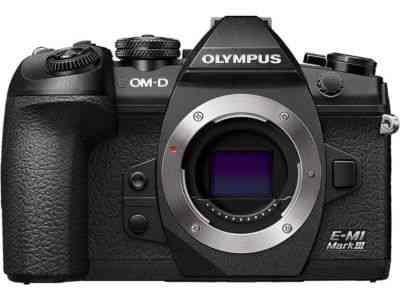
Specifications
- Type: Mirrorless
- Sensor: (Four Thirds) MOS
- Megapixels: 20.4 MP
- Lens Mount: Micro Four Thirds
- Monitor: 3.0″ Articulating Tilting Touchscreen LCD, 1037k Dots
- Viewfinder: LCD EVF, 2360k dots, 100% coverage, 0.74x magnification
- Max continuous shooting speed: 15fps
- Max video resolution:4K
Pros
- Small and Lightweight
- Longer Battery life
- Excellent stabilization
- Weather Sealing
Cons
- EVF needs improvement
The Olympus OM-D E-M1 Mark III embodies a notable improvement over its forerunner, the Mark II. This compact camera showcases notable improvements, primarily in its processing power, which results in enhanced face and eye detection capabilities. Furthermore, it introduces practical features like an 8-way AF joystick, as well as modes such as ‘Hand-Held High Res Shot,’ ‘Live ND,’ and ‘Starry Sky AF.’ The small and lightweight design, along with its lenses, improves its ease of carrying, making it perfect for long-lasting occasions such as weddings and journeys, including hiking expeditions. Regarding its capabilities, the E-M1 Mark III showcases remarkable rapid shooting rates, providing a maximum of 10 frames per second in manual mode and 18 frames per second in electronic mode, which matches those of the E-M1 Mark II.
This camera also benefits from a well-sized buffer, ensuring it can handle fast action effectively. While traditional autofocus methods, like maintaining a fixed point or zone over the subject, work decently, the camera’s subject tracking mode falls short and is less reliable than that of its competitors. However, the face and eye detection features function admirably, and the addition of the new joystick simplifies the process of switching between detected faces. All in all, the Olympus OMD EM1 Mark III is a highly suitable camera system for photographers specializing in wedding and portrait photography.
10. Fujifilm Instax Mini 12: Best Instant Camera
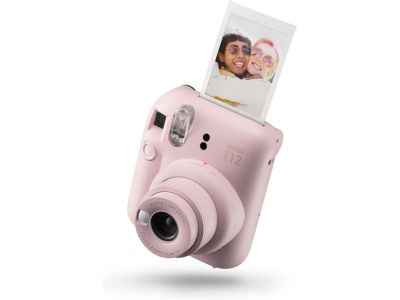
Specifications
- Type: Instant Film Camera
- Viewfinder: Optical
- Focus Type: Fixed
- Exposure Mode: Auto
Pros
- Selfie Mirror
- Cute Design
- Easy to Use
Cons
- Cannot flash off
Committed to capturing the essence of living in the present moment, the FUJIFILM INSTAX MINI 12 Instant Film Camera offers a user-friendly experience and swiftly generates memorable, credit-card-sized photographs. Equipped with a close-up mode and a convenient selfie mirror, it excels at portrait and self-portrait photography. Additionally, the camera’s automatic flash system facilitates capturing images in low-light conditions.
Drawing upon the strengths of its predecessor, the Fuji Film Instax Mini 11, the Mini 12 simplifies the process of creating vivid, compact prints, especially for those new to instant photography. Notably, the Mini 12 incorporates parallax correction, a valuable feature that aligns the framing view with the final print, ensuring a closer match between what you see and what you get. Fujifilm has also repositioned the exposure sensor to provide more accurate readings, although it tends to overexpose in bright sunlight.
While the camera’s design may feel somewhat slippery in hand, it compensates with an even more intuitive lens control system. Activating the Mini 12 is as easy as twisting its lens, and the close-up mode is engaged by a simple pull. This straightforward setup makes it particularly appealing for social gatherings and is well-suited for children, all the while considering the affordability of film refills.
Also Check: Best Action Camera
11. Sony RX100 VII: Best Camera for Travel
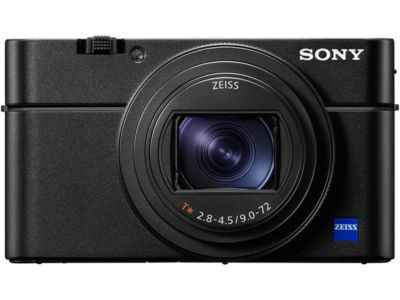
Specifications
- Type: Digital Compact Camera
- Sensor: 1″-Type CMOS
- Megapixels: 20.1 MP
- Lens Mount: E Mount
- Monitor: 3.0″ 180° Tilting Touchscreen LCD, 9216k Dots
- Viewfinder: OLED EVF, 2359k dots, 100% coverage, 0.59x magnification
- Max continuous shooting speed: 20fps
- Max video resolution: 4K
Pros
- Compact Design
- Amazing Image Quality
- Great Autofocus system
Cons
- Average Battery Life
Sony’s RX100 VII exemplifies the brand’s expertise in compact camera technology, boasting an impressive array of features in a remarkably small form factor. This pocket-sized marvel incorporates a versatile 24-200mm equivalent zoom, an electronic viewfinder, a tilting screen, and remarkable capabilities like 20 fps shooting and 4K video recording. For photographers frequently capturing fast-moving subjects, such as in sports or with children, the autofocus system represents a substantial advancement. It undoubtedly stands as the most accomplished pocket camera available today, with a notable suitability for travel photography.
The image quality straight out of the box is exceptional, and the camera’s broad shutter speed range facilitates capturing both extended exposures and fast-moving subjects. Its autofocus system excels in tracking moving subjects and objects, making it appealing for a wide range of photographic scenarios. However, certain drawbacks should be acknowledged. The camera’s compact size and the absence of a dedicated hand grip can lead to discomfort during extended use. Additionally, the relatively short battery life depends on your chosen settings.
The Sony RX100 VII’s autofocus system significantly enhances its appeal for a diverse range of photographers and shooting situations, catering to parents capturing their children’s moments, dog owners immortalizing their pets, and holidaymakers documenting their adventures. Nevertheless, it’s important to note that its price point may present a substantial hurdle, especially considering its 1-inch sensor.
Also Check: Best Point and Shoot Camera (Compact Camera)
12. Samsung Galaxy S23 Ultra: Best Camera Phone
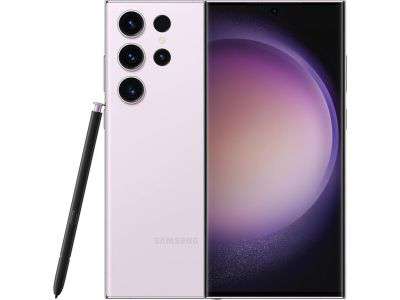
Specifications
- Type: Smartphone Camera
- Rear Cameras: 200 MP (f/1.7), 12MP (f/2.2), 10MP (f/2.4) 3x telephoto, 10MP (f/2.4) 10x telephoto
- Front Camera: 12MP (f/2.2)
- Display: 6.8″ Super AMOLED (3088 x 1440)
- Max continuous shooting speed: 30fps
- Max video resolution: 8K
Pros
- Great Display
- Excellent Camera
- Superfast performance
Cons
- Pricey
The Samsung Galaxy S23 Ultra aims to elevate smartphone photography to new heights with its impressive 200MP camera and various enhancements. After thorough testing, it is seen that the S23 Ultra fulfills all the expectations.
Consequently, what possibilities does possessing a 200-megapixel camera present for you? This sensor can merge 16 pixels into one, resulting in brighter and more detailed photographs. Alternatively, you can opt for the full 200MP mode, granting greater flexibility for cropping and reframing your images.
Among the notable upgrades on the Galaxy S23 Ultra is a more refined 12MP front camera, as well as an exclusive Snapdragon 8 Gen 2 chip tailored for Galaxy devices, delivering impressive graphics performance that surpasses that of the iPhone. The display has been optimized for S Pen usage, and there are noticeable design changes worth mentioning. The rear cameras are even more substantial compared to the Galaxy S22 Ultra, and the display adopts a flatter profile. Although there’s a slight curvature on the 6.8-inch panel, it offers a slimmer curve with a more level surface area, enhancing the comfort of using an S Pen. The phone boasts a remarkable display, exceptional performance, enduring battery life, robust software with seamless S Pen integration, and a top-tier array of cameras.
Buyer’s Guide: Things to Consider Before Purchasing the Best Camera
Choosing to invest in a top-notch camera is a thrilling choice, as it unveils boundless opportunities for imaginative exploration. Regardless of whether you’re a skilled photographer, a passionate hobbyist, or just seeking an enhancement, there are crucial elements to ponder before finalizing your acquisition:
Intended Use
First and foremost, define your purpose. Are you into landscape photography, portraits, sports, or vlogging? Different camera types excel in various scenarios, so knowing your niche is key.
Budget
Determine your spending limit. As mentioned in our article, options range from budget-friendly to high-end. Your budget will influence the brands and models available to you.
Camera Type
Choose between DSLR, mirrorless, or compact cameras. DSLRs provide optical viewfinders and are favored by professionals. Mirrorless cameras are more compact and offer advanced features, while compacts are pocket-sized and user-friendly.
Sensor Size
Sensor size affects image quality. Full-frame sensors offer the best quality, followed by APS-C and micro four-thirds. Consider your need for detail and low-light performance.
Megapixels
Do not become entangled in the competition of megapixels. For the majority of individuals, a camera that possesses a resolution of 20-30 megapixels provides an ample amount of quality.
Lenses
Lens compatibility is crucial. Ensure your chosen camera has a variety of lenses available for your desired style. Research the lens ecosystem for the camera brand you’re interested in.
Autofocus System
A responsive and accurate autofocus system is crucial, especially for fast-action photography. Look for cameras with advanced focusing capabilities.
Image Stabilization
In-body or lens-based image stabilization can be a game-changer, particularly for handheld shots or low-light conditions.
Video Capabilities
If you’re into videography, check the camera’s video features. Look for 4K recording, frame rates, and video-specific functions.
Ergonomics and Handling
Consider the camera’s build quality, grip, and overall ergonomics. It should feel comfortable and intuitive in your hands.
Brand Ecosystem
Assess the manufacturer’s ecosystem. Does it offer a range of accessories, including flashes, remote triggers, and a variety of lenses?
Battery Life
Long-lasting battery life ensures you won’t miss critical shots. Check reviews and user experiences to gauge a camera’s real-world battery performance.
Connectivity
Modern cameras offer Wi-Fi and Bluetooth connectivity for easy file transfer and remote control through smartphone apps.
Reviews and Recommendations
Read professional reviews and seek recommendations from photographers who have hands-on experience with the camera models you’re considering.
Future-Proofing
Consider your growth as a photographer. A camera with room for future expansion, both in terms of features and lenses, may save you from upgrading too soon.
People Also Ask
What’s the best camera for beginners?
A1: For beginners, compact or mirrorless cameras like the Canon EOS R50 or Sony Alpha a6000 are excellent choices. They offer user-friendly interfaces and good image quality to kickstart your photography journey.
What’s the best camera for professional photographers?
A2: Professional photographers often prefer full-frame DSLRs like the Nikon D850 or mirrorless options like the Sony A7 IV or Nikon Z9 for their exceptional image quality and advanced features.
What should I prioritize, megapixels or sensor size?
A3: Sensor size often has a more significant impact on image quality than megapixels. Prioritize sensor size for better low-light performance and dynamic range.
Are smartphone cameras as good as dedicated cameras now?
A4: While smartphone cameras have improved significantly, dedicated cameras still offer superior image quality, manual control, and versatility, making them the preferred choice for many photographers.
Do more expensive cameras always mean better quality?
A5: Not necessarily. When it comes to cameras, those that come with a higher price tag often come bundled with advanced functionalities. However, the camera that would suit you best is contingent upon your requirements. Take into account your personal preferences, financial limitations, and intended purpose before making a decision.
How important is lens selection when choosing a camera?
A7: Lens selection is crucial as it determines the range of photography you can explore. Check if the camera has a versatile lens ecosystem that suits your needs.
Can I use vintage lenses on modern cameras?
A8: Yes, many modern cameras can adapt to vintage lenses, which can be a cost-effective way to expand your lens collection. However, autofocus and electronic features may not work with older lenses.
What’s the best camera for travel photography?
A9: For travel, compact mirrorless cameras like the Sony RX100 VII or Fujifilm X-T4 are great choices. They balance portability with impressive image quality and versatility.
How often should I upgrade my camera?
A10: The need to upgrade varies. If your current camera meets your creative and technical requirements, there’s no rush. Upgrades should align with your growth as a photographer and changing needs.
How We Select, Test, And Review The Best Camera
To find the top-notch camera, our process of selection commences with extensive investigation. We thoroughly explore the market, taking into account the most recent models, expert viewpoints, user feedback, and brand standing. Once we have narrowed down the options, we subject each camera to thorough testing. Our hands-on assessment covers a variety of aspects, encompassing image excellence, sensor performance, autofocus capabilities, low-light proficiency, and ergonomics. We meticulously examine real-life scenarios, ensuring that the camera can handle a wide array of shooting conditions. The camera’s video capabilities and connectivity options are also meticulously examined. The results are then compiled and evaluated based on our predetermined criteria, ultimately leading to an impartial and comprehensive review. Our objective is to furnish you with a reliable and well-informed guide to help you select the ideal camera for your specific requirements, whether you are a professional photographer or an enthusiastic beginner.
Final Verdict
In the realm of photography, where precision and artistry merge, the quest for the best camera ends with the Sony A7 IV. This remarkable device effortlessly combines performance, versatility, and innovation. The Sony A7 IV is truly remarkable, with its advanced capabilities and groundbreaking technology. From its outstanding 33-megapixel sensor to its lightning-fast autofocus system, this mirrorless camera pushes the boundaries of what can be achieved in photography. It establishes a fresh benchmark as the best camera, empowering photographers to seize moments with unrivaled precision and limitless artistic possibilities.
For those who seek a wallet-friendly yet capable option, the Canon EOS R50 is the “Best Budget” camera to consider. It doesn’t compromise on essential features, offering a good balance of performance and affordability. This camera proves that quality photography and videography can be accessible to a broader audience without breaking the bank.

